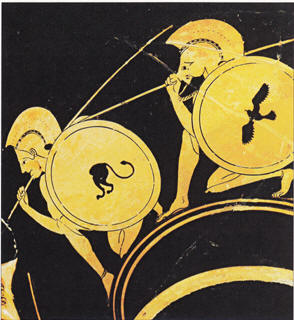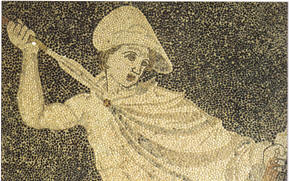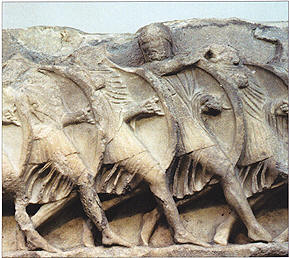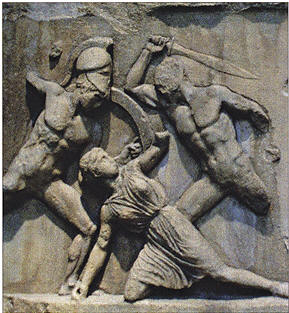Ancient Greek weapons
The ancient Greeks
(c.
750—146Bc) regarded the sword
as strictly an auxiliary weapon, one that would
never supplant their battle-proven reliance on the
spear. The spear enabled the heavily armoured
hoplites, or infantrymen, to stand together and
protect each other within the close formation of
their phalanx wall of shields and spears. This
allowed them to repeatedly fight and win battles
against far superior opposition.
 The
Hoplites The
Hoplites
Infantry foot-soldiers, the
ancient Greek hoplites (from the Greek word
hoplon, or armour) formed the military backbone
of the Greek city states. Hoplites were recruited
mainly from the wealthier and fitter middle classes,
and bore the financial responsibility to arm
themselves. Bronze armour, sword, spear and shield
all had to be provided from solely private means.
Hoplites were not full-time professional soldiers
whose only life was war. They had volunteered to
serve their state only in times of war (usually in
the summer), and, if they survived, would return
afterwards to their civilian roles. The hoplite was
a true manifestation of the classical Greek ideal of
shared civic responsibility.
ABOVE:
Spartan hoplites, c.500Bc, wearing Corinthian
helmets. In addition to the shield and spear,
hoplites would have also carried a sword.
The Spear
A Greek
infantryman’s main battle weapon was the spear, or
doru. Measuring around 2.7m (8.8ft) in length, it
would have been held in one hand, while the shield (aspis)
was grasped in the other. The spearhead was
leaf-shaped, socketed and made of iron. At the butt
of the shaft was a sharp bronze spike, or sauroter
(“lizard killer”), which could be thrust into the
ground for added stability. In extremis, when the
spearhead was broken, the sharp spike could be
flipped around and used as a weapon of last resort.
 The
Macedonians, under the leadership of Alexander the
Great (356—323BC), also developed their own spear or
pike, the sarissa. Little is known about it, but it
is thought to have been up to twice the length
(around 4—5m/13—16.4ft) of the doru and had to be
wielded underarm with two hands. This meant that the
usual protection of the shield-and-spear phalanx
could not be utilized, and so a small shield, or
pelte, was strapped to the left forearm. The
sarissa’s great length meant that it could keep the
opposing troops at a distance, enabling the
Macedonian cavalry to wheel around the flanks of an
enemy and strike with devastating effect. The
Macedonians, under the leadership of Alexander the
Great (356—323BC), also developed their own spear or
pike, the sarissa. Little is known about it, but it
is thought to have been up to twice the length
(around 4—5m/13—16.4ft) of the doru and had to be
wielded underarm with two hands. This meant that the
usual protection of the shield-and-spear phalanx
could not be utilized, and so a small shield, or
pelte, was strapped to the left forearm. The
sarissa’s great length meant that it could keep the
opposing troops at a distance, enabling the
Macedonian cavalry to wheel around the flanks of an
enemy and strike with devastating effect.
ABOVE:
Mosaic showing Alexander the Great, leader of the
Macedonians, hunting a lion with a doru (spear) in
the 3rd century
BC.
The Phalanx -
Ancient Armored Fist
 Derived
from the Greek word
phalangos
(meaning “finger”), the hoplite phalanx was made up
of a tight formation of spearmen, armed with large,
concave shields that rested on the soldier’s left
shoulder and protected the man next to him, thus
forming an all- enveloping, locked curtain of
defence. The phalanx was typically about eight men
deep, with the front ranks projecting their spears
forwards. The key to the success of the phalanx was
the ability of the soldiers to keep together and not
break the formation. This was not always easy,
especially for the first few ranks, who were the
main combatants, as the rear ranks’ main purpose was
to continually push their phalanx forward and
maintain its shape. Derived
from the Greek word
phalangos
(meaning “finger”), the hoplite phalanx was made up
of a tight formation of spearmen, armed with large,
concave shields that rested on the soldier’s left
shoulder and protected the man next to him, thus
forming an all- enveloping, locked curtain of
defence. The phalanx was typically about eight men
deep, with the front ranks projecting their spears
forwards. The key to the success of the phalanx was
the ability of the soldiers to keep together and not
break the formation. This was not always easy,
especially for the first few ranks, who were the
main combatants, as the rear ranks’ main purpose was
to continually push their phalanx forward and
maintain its shape.
ABOVE:
A frieze from the Mausoleum of Halicarnassus,
c.35OBc,
depicting a mythical battle between the Greeks and
the Amazons.
There has been much debate as to how the spear was
used while in the phalanx: was it held aloft or
under the arm? Some authorities believe that it had
to be held aloft, as it would have been impractical
for a hoplite to hold his spear underarm, in case
the sharp butt spike injured the man behind him. The
use of the sword by the hoplites in the phalanx
would have been regarded as a highly dangerous
manoeuvre, because it necessitated breaking up the
shape and, consequently, the defensive cohesion of
the phalanx.
The Sword
 There
is great irony in noting that the most successful
sword design of the Ancient World was developed by
the Greeks, who were ostensibly spearmen. The sword
was never regarded as a main battle weapon and
played a purely secondary role. Once the spears had
been thrown or lost in battle, swords were then
engaged to finish the conflict in a decisive manner. There
is great irony in noting that the most successful
sword design of the Ancient World was developed by
the Greeks, who were ostensibly spearmen. The sword
was never regarded as a main battle weapon and
played a purely secondary role. Once the spears had
been thrown or lost in battle, swords were then
engaged to finish the conflict in a decisive manner.
The main battle sword of the ancient Greek military
was the xiphos. Introduced around 800—400Bc,
it
comprised a straight,
double-edged, leaf-shaped blade of around 65cm
(25.6in), and was particularly effective at slashing
and stabbing. The Spartans carried a slightly
shorter sword of the same design as the xiphos. This
design probably influenced the later Roman gladius,
or short sword.
Mounted Greek cavalry used a curved sword, or
makhaira (meaning “to fight”). It had a large,
slightly curved falchion-type blade and was designed
to deliver a heavy slashing blow at speed.
The use of a curved blade for mounted horsemen would
remain a constant feature of cavalry swords for the
next 2,500 years.
ABOVE:
A stone depiction of Greek hoplites standing in
phalanx formation, from c.400BC.
|